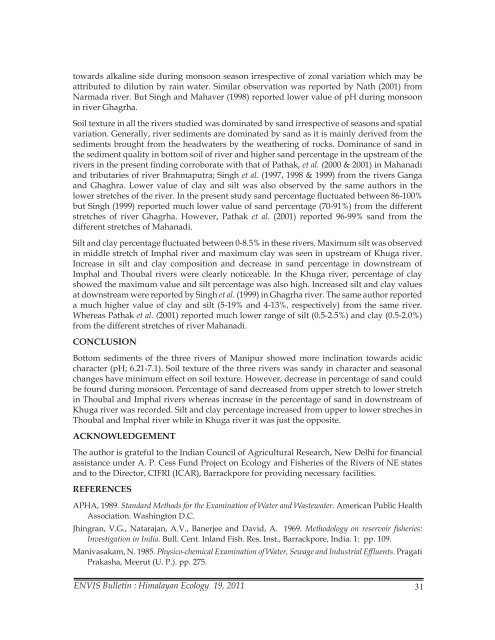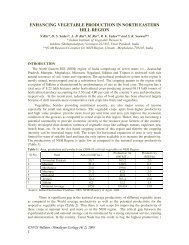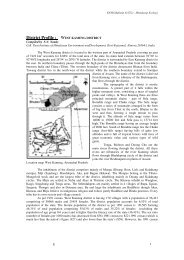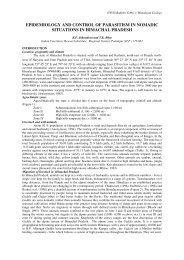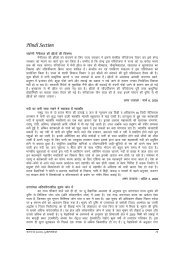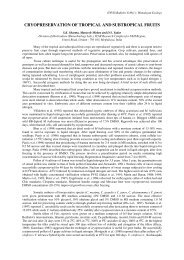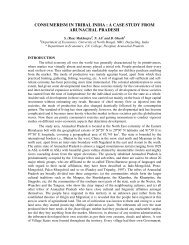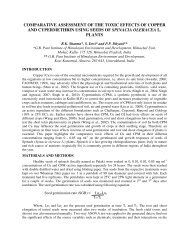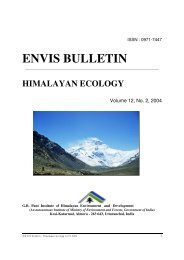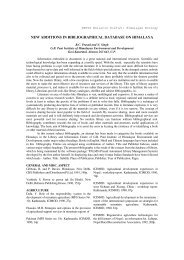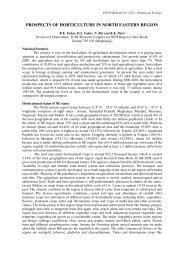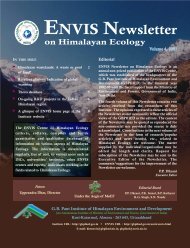Complete Bulletin (PDF) - ENVIS Centre on Himalayan Ecology
Complete Bulletin (PDF) - ENVIS Centre on Himalayan Ecology
Complete Bulletin (PDF) - ENVIS Centre on Himalayan Ecology
You also want an ePaper? Increase the reach of your titles
YUMPU automatically turns print PDFs into web optimized ePapers that Google loves.
towards alkaline side during m<strong>on</strong>so<strong>on</strong> seas<strong>on</strong> irrespective of z<strong>on</strong>al variati<strong>on</strong> which may beattributed to diluti<strong>on</strong> by rain water. Similar observati<strong>on</strong> was reported by Nath (2001) fromNarmada river. But Singh and Mahaver (1998) reported lower value of pH during m<strong>on</strong>so<strong>on</strong>in river Ghagrha.Soil texture in all the rivers studied was dominated by sand irrespective of seas<strong>on</strong>s and spatialvariati<strong>on</strong>. Generally, river sediments are dominated by sand as it is mainly derived from thesediments brought from the headwaters by the weathering of rocks. Dominance of sand inthe sediment quality in bottom soil of river and higher sand percentage in the upstream of therivers in the present finding corroborate with that of Pathak, et al. (2000 & 2001) in Mahanadiand tributaries of river Brahmaputra; Singh et al. (1997, 1998 & 1999) from the rivers Gangaand Ghaghra. Lower value of clay and silt was also observed by the same authors in thelower stretches of the river. In the present study sand percentage fluctuated between 86-100%but Singh (1999) reported much lower value of sand percentage (70-91%) from the differentstretches of river Ghagrha. However, Pathak et al. (2001) reported 96-99% sand from thedifferent stretches of Mahanadi.Silt and clay percentage fluctuated between 0-8.5% in these rivers. Maximum silt was observedin middle stretch of Imphal river and maximum clay was seen in upstream of Khuga river.Increase in silt and clay compositi<strong>on</strong> and decrease in sand percentage in downstream ofImphal and Thoubal rivers were clearly noticeable. In the Khuga river, percentage of clayshowed the maximum value and silt percentage was also high. Increased silt and clay valuesat downstream were reported by Singh et al. (1999) in Ghagrha river. The same author reporteda much higher value of clay and silt (5-19% and 4-13%, respectively) from the same river.Whereas Pathak et al. (2001) reported much lower range of silt (0.5-2.5%) and clay (0.5-2.0%)from the different stretches of river Mahanadi.CONCLUSIONBottom sediments of the three rivers of Manipur showed more inclinati<strong>on</strong> towards acidiccharacter (pH; 6.21-7.1). Soil texture of the three rivers was sandy in character and seas<strong>on</strong>alchanges have minimum effect <strong>on</strong> soil texture. However, decrease in percentage of sand couldbe found during m<strong>on</strong>so<strong>on</strong>. Percentage of sand decreased from upper stretch to lower stretchin Thoubal and Imphal rivers whereas increase in the percentage of sand in downstream ofKhuga river was recorded. Silt and clay percentage increased from upper to lower streches inThoubal and Imphal river while in Khuga river it was just the opposite.ACKNOWLEDGEMENTThe author is grateful to the Indian Council of Agricultural Research, New Delhi for financialassistance under A. P. Cess Fund Project <strong>on</strong> <strong>Ecology</strong> and Fisheries of the Rivers of NE statesand to the Director, CIFRI (ICAR), Barrackpore for providing necessary facilities.REFERENCESAPHA, 1989. Standard Methods for the Examinati<strong>on</strong> of Water and Wastewater. American Public HealthAssociati<strong>on</strong>. Washingt<strong>on</strong> D.C.Jhingran, V.G., Natarajan, A.V., Banerjee and David, A. 1969. Methodology <strong>on</strong> reservoir fisheries:Investigati<strong>on</strong> in India. Bull. Cent. Inland Fish. Res. Inst., Barrackpore, India. 1: pp. 109.Manivasakam, N. 1985. Physico-chemical Examinati<strong>on</strong> of Water, Sewage and Industrial Effluents. PragatiPrakasha, Meerut (U. P.). pp. 275.<str<strong>on</strong>g>ENVIS</str<strong>on</strong>g> <str<strong>on</strong>g>Bulletin</str<strong>on</strong>g> : <strong>Himalayan</strong> <strong>Ecology</strong> 19, 2011 31


